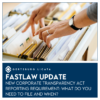A well-crafted liability waiver can save a business hundreds of thousands of dollars in legal fees and judgments. Unfortunately, updating a waiver, like updating insurance policies or reviewing vendor agreements, is one of those things that too many businesses put off until it’s too late and they’ve missed the opportunity to protect themselves.
Take the real-world case of Evans v. Fitness & Sports Clubs, LLC in Pennsylvania. 63-year-old Patricia Evans fractured her wrist while doing “suicide runs” – a set of intense agility movements – under the direction of an LA Fitness personal trainer. On Summary Judgment, the Court found for LA Fitness on the basis that the waiver of liability that Evans signed barred any claim for negligence against LA Fitness.
Contrast that to Barrish v. Crossfit Inc. in Missouri. In the Crossfit case, Jonas Barrish damaged a spinal disc when he disregarded his CrossFit instructor’s warnings and attempted to deadlift a weight well in excess of the instructor’s recommendations. Barrish had not signed any waiver, and a jury gave him $200,000.00 in damages.
The difference lay in a liability waiver, buried in the stack of intake documents that new gym members are given, which Evans signed and Barrish did not.
These examples illustrate the real-life power of a liability release form. If your business involves activities that present a risk to customers, employees, agents, or invitees, you need to secure a signed liability waiver. The waiver form itself must be narrowly tailored to the activity but broad enough to protect against every associated risk.
Crafting Your Waiver Form
Liability waivers have three goals in mind: to identify risks, to evidence that the participant acknowledges and accepts the risks, and to indemnify the company facilitating the activity.
Describe the Activity. Early on, the waiver should identify the activity or activities in general terms. Don’t be so narrow that you exclude legitimate risks that participants may face. Something as simple as “ziplining” or “inventory movement” may be enough.
List the Contemplated Risks. This unexhaustive list should include the most common and dangerous risks associated with the activity: death, physical injury, illness, and economic or emotional loss, for example.
Voluntary Participation. This statement should be conspicuous in the document (bold, capitalized), and should state that the participant voluntarily undertakes the task at his or her own risk and is aware of such risk.
Indemnification. Here, the participant agrees to indemnify and hold the company harmless against all disputes as a result of injury or damage from the activity. This provision may go so far as to indemnify company agents for errors and omissions. However, courts are hesitant to extend waivers to acts of negligence; so be aware that there is an outer limit to the utility of the waiver.
List Those Indemnified. The waiver should list all who are exculpated: the company itself, along with its affiliates, managers, agents, attorneys, staff, volunteers, etc.
Acknowledgment and Understanding. Just before the signature, this provision should state that the participant has fully read and contemplated and understands the contents of the liability waiver.
Execution. The participant should sign not just for himself, but on behalf of his heirs, assigns, and personal representatives so that no one else can inherit the claim if the participant becomes deceased or disabled.
Remember that some states will uphold certain waivers while others won’t enforce them. For example, if Patricia Evans had sued LA Fitness under New York law it’s likely that the waiver would have been thrown out and the case could have gone very differently for LA Fitness. Before crafting a waiver, be sure to discuss it with an attorney to make sure that your state will enforce it.
Gertsburg Licata is a full-service, strategic growth advisory firm focusing on business transactions and litigation, M&A, and executive talent solutions for start-up and middle-market enterprises. It is also the home of CoverMySix®, a unique, anti-litigation audit developed specifically for growing and middle-market companies.
This article is for informational purposes only. It is merely intended to provide a very general overview of a certain area of the law. Nothing in this article is intended to create an attorney-client relationship or provide legal advice. You should not rely on anything in this article without first consulting with an attorney licensed to practice in your jurisdiction. If you have specific questions about your matter, please contact an attorney licensed to practice in your jurisdiction.

